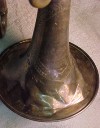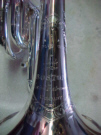Excerpts from a 1913 Boston Musical Instrument Co. 3 Star Cornet catalog.

As with all antique brass instruments about to undergo full restoration, a complete evaluation must first be taken into account. Individuals responsible for performing this task will be checking for missing components: buttons, caps, water keys, etc. Also, they must look for excessive corrosion, cracks and must plan the approach in the repair of severe damage.

After a thorough initial cleaning, the process of dismantling the instrument begins. Great care must be taken not to be too aggressive when removing parts. Forcing the release of soldiered components can cause even more damage to the instrument.

When performing the disassembly process, the mouthpipe and master tuning slide are always the first to be removed. These parts are normally where excessive corrosion and metal fatigue are discovered. At this stage, arrangements to fabricate a replacement mouthpipe would be addressed. Luckily, the mouthpipe on this particular instrument was discovered to be completely sound and would be saved.

Unlike most restorations, when dealing with very old brass instruments, a complete disassembly of the valve set must be undertaken. All soldiered joints must be cleaned of all previous existing soldier. This will insure that during the assembly and replating process no broken joints or leaks will be discovered.

The process of reforming the bell on any brass wind requires a great deal of concentration. Care must be taken not to crack the bell or transform the shape contrary to what it was originally. Using polished steel burnishers on the proper bell form mandrel and employing the use of what we in the business know as a "dent machine", the bell is carefully returned to its original state.

Once the bell has been returned to its original shape, it is ready to undergo polishing. During this process, marring and burnishing scratches are removed.

Once the instrument has had all parts removed and repaired, they are very carefully cleaned and polished, the task of removing the dents has been completed. This process has taken more time than all other parts of the job combined. Great care is observed in the removal of dents and creases as to not crack or thin the metal. This being completed, the instrument is ready to be reassembled.

After reassembly, the instrument is very carefully buffed. Great efforts were made not to round over any edges, knerled, or engraved surfaces. The instrument was then degreased, and plated in bright silver.

This image shows the detailed engraving found on all Boston 3 Star Cornets. It also demonstrates to what extent care must be taken during the polishing process not to damage or obliterate what was so expertly executed by the master engravers of the early 20th century.

Though 24 karat gold plating was not originally on the bell interior of this particular cornet, it was an option abvailable from the Boston Musical Instrument Co. We chose to include this option in the restoration.